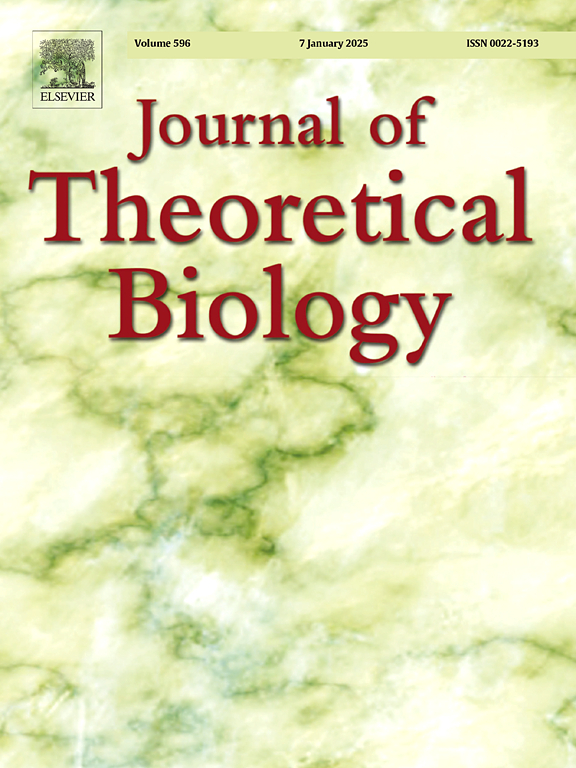Simulations probe the role of space in the interplay between drug-sensitive and drug-resistant cancer cells
IF 1.9
4区 数学
Q2 BIOLOGY
引用次数: 0
Abstract
The interplay between drug-sensitive and drug-resistant cancer cells has been observed to impact cell-to-cell interactions in experimental settings. However, the role that space plays in these interactions remains unclear. In this study, we develop mathematical models to investigate how spatial factors affect cell-to-cell competition between drug-sensitive and drug-resistant cancer cells in silico. We develop two baseline models to study cells from the epithelial FaDu cell line subjected to two drugs, specifically the ATR inhibitor ceralasertib and the PARP inhibitor olaparib, that target DNA damage response pathways. Our baseline models are: (1) a temporally resolved ordinary differential equation (ODE) model, and (2) a spatio-temporally resolved agent-based model (ABM). The models simulate cells in well-mixed and spatially structured cell systems, respectively. The ODE model is calibrated against in vitro data and is thereafter mapped onto the baseline ABM which, in turn, is extended to enable a simulation-based investigation on how spatial factors impact cell-to-cell competition. Simulation results from the extended ABMs demonstrate that the in silico treatment responses are simultaneously affected by: (i) the initial spatial cell configurations, (ii) the initial fraction of drug-resistant cells, (iii) the drugs to which cells express resistance, (iv) drug combinations, (v) drug doses, and (vi) the doubling time of drug-resistant cells compared to the doubling time of drug-sensitive cells. These results reveal that spatial structures of the simulated cancer cells affect both cell-to-cell interactions, and the impact that these interactions have on the ensuing population dynamics. This leads us to suggest that the role that space plays in cell-to-cell interactions should be further investigated and quantified in experimental settings.
模拟探索了空间在药物敏感和耐药癌细胞之间相互作用中的作用。
在实验环境中,已经观察到药物敏感和耐药癌细胞之间的相互作用会影响细胞间的相互作用。然而,空间在这些相互作用中扮演的角色仍然不清楚。在这项研究中,我们建立了数学模型来研究空间因素如何影响药物敏感和耐药癌细胞之间的细胞间竞争。我们开发了两个基线模型来研究受到两种药物(特别是ATR抑制剂ceralasertib和PARP抑制剂olaparib)靶向DNA损伤反应途径的上皮FaDu细胞系的细胞。我们的基线模型是:(1)时间分辨常微分方程(ODE)模型,(2)时空分辨基于主体的模型(ABM)。这些模型分别模拟混合良好的细胞和空间结构的细胞系统。ODE模型根据体外数据进行校准,然后映射到基线ABM,进而扩展到基于模拟的研究空间因素如何影响细胞间竞争。扩展ABMs的模拟结果表明,计算机处理反应同时受到以下因素的影响:(i)初始空间细胞构型,(ii)耐药细胞的初始比例,(iii)细胞表达耐药的药物,(iv)药物组合,(v)药物剂量,以及(vi)耐药细胞与药敏细胞相比的倍增时间。这些结果表明,模拟癌细胞的空间结构既影响细胞间的相互作用,也影响这些相互作用对随后的种群动态的影响。这导致我们建议空间在细胞间相互作用中所起的作用应该在实验环境中进一步研究和量化。
本文章由计算机程序翻译,如有差异,请以英文原文为准。
求助全文
约1分钟内获得全文
求助全文
来源期刊
CiteScore
4.20
自引率
5.00%
发文量
218
审稿时长
51 days
期刊介绍:
The Journal of Theoretical Biology is the leading forum for theoretical perspectives that give insight into biological processes. It covers a very wide range of topics and is of interest to biologists in many areas of research, including:
• Brain and Neuroscience
• Cancer Growth and Treatment
• Cell Biology
• Developmental Biology
• Ecology
• Evolution
• Immunology,
• Infectious and non-infectious Diseases,
• Mathematical, Computational, Biophysical and Statistical Modeling
• Microbiology, Molecular Biology, and Biochemistry
• Networks and Complex Systems
• Physiology
• Pharmacodynamics
• Animal Behavior and Game Theory
Acceptable papers are those that bear significant importance on the biology per se being presented, and not on the mathematical analysis. Papers that include some data or experimental material bearing on theory will be considered, including those that contain comparative study, statistical data analysis, mathematical proof, computer simulations, experiments, field observations, or even philosophical arguments, which are all methods to support or reject theoretical ideas. However, there should be a concerted effort to make papers intelligible to biologists in the chosen field.

 求助内容:
求助内容: 应助结果提醒方式:
应助结果提醒方式:


